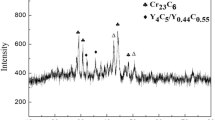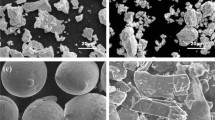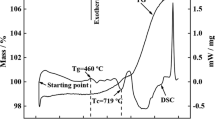Abstract
By varying the tempering temperature, the effects of various tempering temperatures on the microstructure and properties of the coating were investigated. The results show that after heat treatment, eutectic carbides of the original coating disappear and spherical granular carbides resurface. The form and size of alloy carbide alter as the tempering temperature changes. The alloy carbide microstructure size is more rounded when the tempering temperature is 500 °C, and the average hardness is 658 HV, which is 4.9% greater than the original coating. The wear loss is least at a tempering temperature of 500 °C. The abrasion loss is 0.46 and 0.76 times that of the original coating when the load is 50 N and 75 N, respectively. The corrosion current density after tempering at 700 °C is the lowest in the electrochemical experiment, but the self-corrosion potential is the largest.










Similar content being viewed by others
References
Zhang D K, Liu Y, and Yin Y, J Therm Spray Technol 25 (2016) 535. https://doi.org/10.1007/s11666-015-0370-8.
Asl S K, Rabizadeh T, and Noori N F, Prot Met Phys Chem+ 55 (2019) 936. https://doi.org/10.1134/S2070205119050022.
Xu G, Kutsuna M, Liu Z J, and Zhang H, Mat Sci Eng A 417 (2006) 63. https://doi.org/10.1016/j.msea.2005.08.192.
Zhang L M, Sun D B, Yu H Y, and Li H Q, Mat Sci Eng A 457 (2007) 319. https://doi.org/10.1016/j.msea.2006.12.047.
Luo K Y, Xu X, Zhao Z, Zhao S S, Cheng Z G, and Lu J Z, J Mater Process Tech 263 (2019) 50. https://doi.org/10.1016/j.jmatprotec.2018.08.005.
Liu X B, and Gu Y J, Mater Lett 60 (2005) 577. https://doi.org/10.1016/j.matlet.2005.09.041.
Tang M Q, Wang W, Li G, Feng Z Q and Zhang R Z, Int J Electrochem Sc 14 (2019) 1591. https://doi.org/10.20964/2019.02.74.
Yuan Y L, and Li Z G, Appl Surf Sci 423 (2017) 13. https://doi.org/10.1016/j.apsusc.2017.06.080.
Xiang Z N, Li Z J, Chang F, and Dai P Q, Metals 9 (2019) 1302. https://doi.org/10.3390/met9121302.
Acknowledgements
The author acknowledges the financial support from Science and Technology Project of Datang Electric Power Group (KY-2018-03), Lusi Project of Datang Electric Power Group (KY-2019), the Key Technology R&D Program of Anhui Province (201904Aa05020084), Industrial guiding fund of Changfeng county and Hefei University of Technology (JZ2019QTXM0281) and fund of Anhui Wanan Co. Ltd (W2019JSKF0210).
Author information
Authors and Affiliations
Corresponding author
Additional information
Publisher's Note
Springer Nature remains neutral with regard to jurisdictional claims in published maps and institutional affiliations.
Rights and permissions
About this article
Cite this article
Wang, S., Tao, S., Sun, S. et al. Microstructure and Properties of Fe-Based Coating after Tempering. Trans Indian Inst Met 75, 1619–1627 (2022). https://doi.org/10.1007/s12666-022-02537-1
Received:
Accepted:
Published:
Issue Date:
DOI: https://doi.org/10.1007/s12666-022-02537-1




